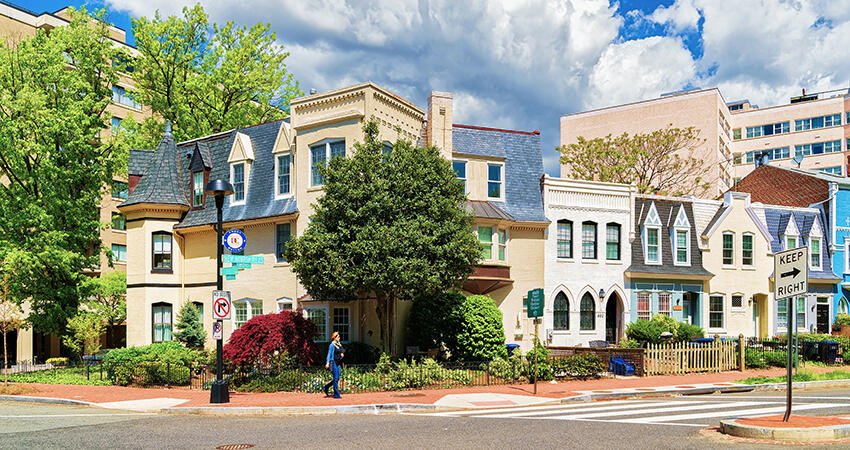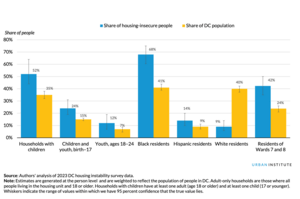
(Roman Babakin/Shutterstock)
How Big Is the Problem of Housing Insecurity?
What We Learned from the District of Columbia
Housing insecurity is a complex experience that includes multiple dimensions, such as being forced to move, consistently being unable to afford housing, or living in poor-quality housing conditions, like overcrowding or having rodents or mold. Given this complexity, no standard definition or measure of housing insecurity exists to date.
The US Department of Housing and Urban Development’s worst case housing needs reports, which are currently one of the largest efforts to measure this, combine housing affordability and some measures of severely inadequate housing among renter households based on American Housing Survey data. Data compiled from the last few reports shows between 15 and 16 percent of renter households without housing assistance were experiencing severe housing problems between 2015 and 2021. Although consistently measured, it paints an incomplete picture of housing insecurity, lacking information on histories of evictions or forced moves, more aspects of unaffordability, and predictions of near-future housing stability. Similarly, the US Census Bureau’s Household Pulse Survey has a series of questions around housing security and feelings of pressure to move. An analysis of one of these questions showed a striking 44 percent of renter households reported feeling pressure to move from their current home in the previous six months during the pandemic. However, the sample size of this study is generally small with high rates of nonresponse, making it harder to generalize from.
Understanding the full breadth of housing insecurity is critical to better plan for and support households before they lose shelter or suffer the consequences of living in an uncertain or stressful housed environment. For example, we know that children’s well-being, including their academic achievement, behavioral health, and physical heath, suffers when living in more crowded living conditions. The type of insecurity people face is important to know because assistance programs or solutions posed will differ depending on the challenges faced. A push for efforts to measure aspects of housing insecurity emerged in response to the COVID-19 pandemic, as policymakers and program administrators sought guidance in directing resources.
Motivated by a desire to plan for potential fallout from the COVID-19 pandemic, the Community Partnership for the Prevention of Homelessness—an independent nonprofit that coordinates the District of Columbia’s continuum of care on behalf of the city—partnered with the Urban Institute to look at the extent of housing insecurity experienced by DC residents. The research team designed a survey informed by relevant literature as well as focus groups and one-on-one interviews with people with lived experience and staff in organizations focused on different types of housing insecurity, such as rental and mortgage assistance.
To be flagged as housing insecure, residents must meet one of three circumstances: currently having an eviction notice, being very likely to face eviction or foreclosure within three months, and involuntarily residing with a household temporarily because they can’t afford to live elsewhere. Residents may also be flagged if they meet any 5 of 17 conditions that cover several dimensions of housing insecurity, such as overcrowding, poor housing quality, insufficient rental assistance, frequent moves in the past year, uncertainty in their ability to pay the next rent or mortgage payment, or having been forced to leave or evicted in the past year. Nearly half of all housing-insecure people had 6 or more flags, and among those who exhibited an automatic inclusion flag, nearly half still had 4 or more flags.
Findings from the study show that 12 percent of DC residents, or an estimated 82,452 people, are experiencing housing insecurity. Among those facing housing insecurity, the most common type is unaffordability, followed by inadequate housing and frequent or unwanted moves. Within the 82,452 people experiencing housing insecurity, slightly more than half predict that they’re either unlikely to have a stable place to stay in the next three months, would not have a safe place to go if they had to leave their housing, or are likely to be evicted or foreclose in the next three months. And, among those experiencing housing insecurity, about 30 percent are involuntarily living with another household temporarily, such as by doubling up or couch surfing, because they cannot afford another place.
Some DC residents are overrepresented among those experiencing housing insecurity relative to their shares of the city’s total population: families with children, children and young people under age 25, Black and Hispanic residents, and residents of Wards 7 and 8.
People Experiencing Housing Insecurity in DC by Household Characteristics

In DC, findings can help better target resources equitably to areas and groups of people in need. With unaffordability as the dominant type of housing insecurity, a critical step toward alleviating this strain is to expand affordable housing solutions. One more immediate solution could be to expand the Emergency Rental Assistance Program, which was started during the pandemic, and ensure it’s equitably offered to address disproportionate need, such as concentrating its use among residents in Wards 7 and 8.
The findings in DC suggest we need a shared definition of housing insecurity to better understand the extent of the problem in other communities. Having a clearer sense of the challenge can provide more guidance to understand what type of funding and programming is needed to sufficiently stabilize households at risk of housing insecurity.
Though this is a complicated and multifaceted issue, the US has already demonstrated the capacity to address it; the US successfully engaged a large-scale federal effort to define and measure homelessness. This approach resulted in the first nationwide count of homelessness in 2007. Since then, we’ve been able to annually track the rise and decline of homelessness in the US overall and for certain populations, such as veterans, unaccompanied youth, and families with children, through the Homeless Management Information System (HMIS). This has allowed us to better understand how policies and programs might affect trends in homelessness. It’s also allowed for more clarity in communicating about challenges and evidence-based solutions.
Given our experiences, we have clear next steps for better measuring and understanding the extent of housing insecurity. First, we should align around the need for a consistent and comprehensive measure of housing insecurity. This could include building consensus among offices and organizations that may benefit from learning more about housing insecurity, including continuums of care, state housing offices, and housing advocates. Building momentum and support among these partners can help highlight the importance of a unified, comprehensive definition. Second, it’s critical to identify pathways to develop this measure, either by modifying existing data collection processes or establishing new data collection pathways, as demonstrated by the HMIS. Finally, generating both political will and a funding mechanism will be critical for both implementation and sustainability of the measure.


